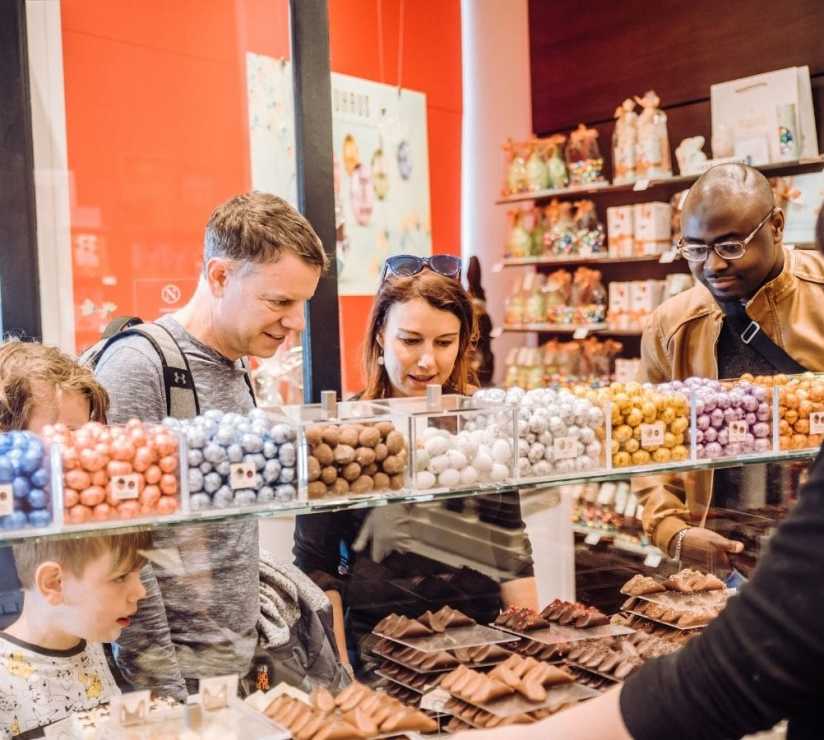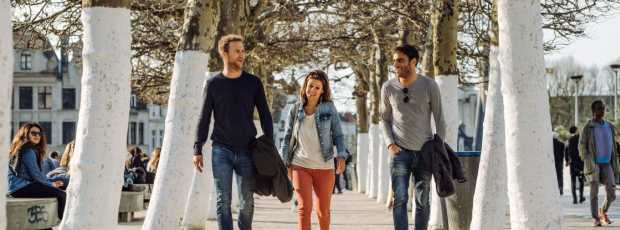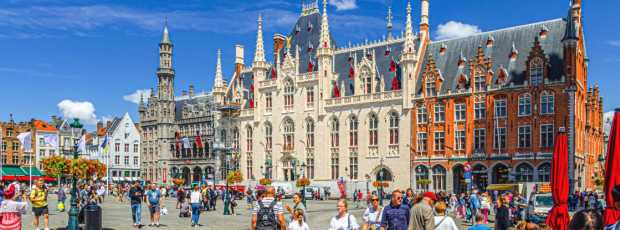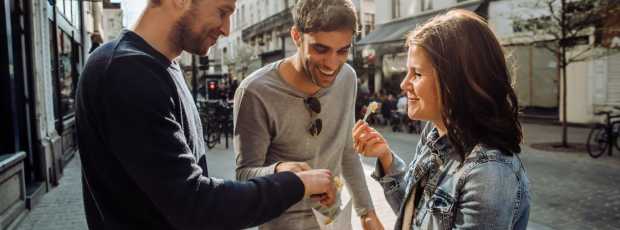Table Of Contents
- What Makes Grand Place Brussels' Most Deceptive Wonder?
- Where Does Mont des Arts Offer the City's Most Honest Views?
- How Does the Magritte Museum Reveal Brussels' Surreal Soul?
- Where Do Brussels' Best Beer Gardens Hide from Tourist Crowds?
- How Do Belgian Comics Come Alive Beyond the Obvious Museums?
- Why Does Parc du Cinquantenaire Reveal Brussels' Imperial Dreams?
- How Does Mini Europe Transform Brussels into a Continental Theme Park?
- What Makes June Brussels' Most Underrated Season?
- How Can Three Days Transform Your Understanding of Brussels?
- Why Should July Follow Your June Brussels Discovery?
June in Brussels feels like the city finally exhaled after months of grey drizzle. I'm sitting in Place Eugène Flagey watching tourists emerge from the metro, blinking in actual sunlight, clutching their guidebooks like talismans. They're here for the obvious things to do in Brussels in June, the Grand Place, the Atomium, maybe a waffle crawl. But June reveals layers of this city that most visitors miss entirely.
The light hits differently here in early summer. It slants through the Art Nouveau windows on Rue Antoine Dansaert, catches the gold leaf on the Brussels Town Hall spire, and somehow makes even the concrete brutalism of the European Quarter look almost dignified. The locals shed their winter armor of black coats and emerge onto terraces, beer glasses catching that late evening light that lingers until nearly 10 PM.
This isn't your typical tourist checklist. I've lived here long enough to know that Brussels in summer operates on its own peculiar rhythm, part European capital, part village square, entirely unpredictable. Let me show you the city as it actually unfolds in June.
What Makes Grand Place Brussels' Most Deceptive Wonder?
Everyone comes to Grand Place. It's unavoidable, really, the UNESCO World Heritage Site sits like a gilded spider in the web of Brussels' medieval heart. But here's what they don't tell you: the Grand Place transforms completely depending on when you visit.
At 7 AM in June, before the tour buses arrive, the cobblestones still hold the cool of night. The guild houses stand in perfect silence, their gold details catching the first light. The Brussels Town Hall Gothic spire points into a sky so blue it feels almost aggressive after months of Brussels grey. This is when the Grand Place belongs to the street sweepers, the café owners setting up tables, and the occasional jogger cutting through on their way to the park.
By afternoon, it's a different beast entirely. Tour groups flow in waves, smartphones held high, everyone trying to capture the same postcard angle. But stick around until evening, June brings outdoor concerts, temporary exhibitions in the adjacent buildings, and that particular Brussels phenomenon where locals suddenly appear, claiming tables as if they'd been there all along.
The impressive architecture demands multiple visits. Each guild house tells a story of medieval trade power, the bakers, the brewers, the boatmen all staking their claims in stone and gold leaf. The town hall with its opulent decorations dates back to the middle ages, but don't let the history books fool you. This place pulses with current life.
Grand Place in summer reveals itself in layers, arrive early for solitude, return in evening for the real Brussels energy.
Where Does Mont des Arts Offer the City's Most Honest Views?
Mont des Arts sits like Brussels' public balcony, offering panoramic views that shift with the light throughout the day. In June, this becomes my favorite spot to understand how the city of Brussels actually fits together, the medieval core, the grand boulevards, the green spaces threading between districts.
The formal gardens here feel almost Parisian, all geometric precision and manicured hedges. But this is Brussels, so there's always something slightly askew, a skateboarder cutting through the fountain area, office workers eating lunch on the steps in suits and sneakers, tourists consulting maps while locals stride past with the confidence of people who actually know where they're going.
The Brussels skyline unfolds in layers from here. The cathedral spires of Saint Michael pierce the foreground, the European Quarter's glass towers glint in the distance, and on clear June days, you can trace the green ribbons of park space that weave through the urban fabric. The Royal Palace sits just below, its neoclassical bulk looking suitably important but somehow less imposing from this angle.
What makes Mont des Arts special isn't just the views, it's the layers of Brussels culture stacked literally on top of each other. The Magritte Museum sits at one end, housing the world's largest collection of the surrealist master's work. The Royal Library forms another boundary, its reading rooms full of researchers and students.
June brings street musicians to the steps, art students sketching the panoramic views, and that particular Brussels mix of languages drifting up from café conversations below. The evening light here turns the entire city golden, making even the most mundane apartment blocks look like they're posing for postcards.
Mont des Arts provides Brussels' best introduction, arrive for the views, stay to understand how the city's layers actually connect.
Looking for a private city experience in Brussels?
Explore the city with a local who plans a private day just for you; no groups, no scripts.
How Does the Magritte Museum Reveal Brussels' Surreal Soul?
The Magritte Museum occupies a corner of the Royal Palace complex that feels deliberately understated. No grand entrance, no swooping modern architecture, just a doorway that leads into the universe of René Magritte, Belgium's master of the impossible made ordinary.
June brings enough light streaming through the museum windows to create its own surreal atmosphere. Magritte lived most of his life in Brussels, in a modest house in Jette that you can still visit. But here, in the Magritte Museum, you encounter the full scope of his visual games, men in bowler hats floating through blue skies, apples that block faces, pipes that insist they are not pipes.
The museum spreads across multiple floors, each room building on Magritte's central obsession: the gap between what we see and what we think we know. The René Magritte Museum doesn't just display his paintings, it recreates the mental space where everyday Brussels reality bends into something far more interesting.
What strikes me most about visiting in Brussels summer is how Magritte's work suddenly makes sense in context. This city thrives on contradictions, medieval squares surrounded by glass office towers, bureaucrats sharing café tables with artists, conversations that slide between French, Dutch, and English within single sentences. Magritte painted a world where logic goes on vacation, which feels entirely appropriate for a city that serves as Europe's capital while maintaining the atmosphere of an overgrown village.
The temporary exhibitions often focus on Magritte's influence on contemporary artists, creating dialogues between his 20th-century surrealism and current Brussels creativity. The audio guide provides context, but honestly, Magritte's visual jokes work best when you let them hit without explanation.
The Magritte Museum transforms Brussels' everyday surrealism into high art, perfect for understanding why this city never quite makes logical sense.
Where Do Brussels' Best Beer Gardens Hide from Tourist Crowds?
Belgian beer culture runs deeper than most tourists realize, and June reveals the city's best drinking spots beyond the obvious tourist traps around Grand Place. Real Brussels beer culture happens in neighborhood cafés and hidden gardens where locals gather to argue about politics, football, and the proper way to pour a Duvel.
Delirium Café gets all the guidebook attention, but walk 10 minutes into the Marolles neighborhood and you'll find Café des Halles, where the owner maintains a beer list that changes with his mood and the season. The garden behind the bar fills with locals in June, conversations flowing between French and Dutch while the evening light filters through plane trees.
The Brussels Card offers discounts at participating breweries, but the real discoveries happen when you abandon your guidebook entirely. Cantillon Brewery in Anderlecht still produces lambic beers using wild yeasts that float through Brussels air. Their guided tours feel more like visiting a working laboratory than a tourist attraction, and the tasting room serves beers that taste like liquid history.
What makes Brussels beer culture special isn't just the variety, it's the social ritual. Locals don't just drink beer; they inhabit cafés like extended living rooms. June brings this outdoor, as terrace tables expand onto sidewalks and small squares. Each beer comes with its proper glass, served at the correct temperature, often accompanied by free nuts or cheese cubes that appear without ordering.
The neighborhood around Saint Hubert galleries hides several bars that locals guard jealously. À la Mort Subite serves traditional Brussels gueuze in a tiled interior that hasn't changed since the 1920s. The whole family of lambic beers, gueuze, kriek, faro, tells the story of Brussels' brewing heritage in liquid form.
Brussels' beer culture reveals itself in neighborhood cafés where locals gather, skip the tourist spots, follow the conversations in multiple languages.
How Do Belgian Comics Come Alive Beyond the Obvious Museums?
Belgian comics built a cultural empire that extends far beyond Tintin and the Smurfs, and Brussels wears its comic heritage like a second skin. The Comics Art Museum provides the official introduction, but June reveals how comic art actually lives in the city's everyday fabric.
The comic strip murals scattered throughout Brussels turn the city into an open-air gallery. These aren't tourist decorations, they're serious art installations that transform blank walls into storytelling spaces. The Tintin mural on Rue de l'Étuve draws crowds, but seek out the Lucky Luke painting in Schaerbeek or the Broussaille mural near Place Eugène Flagey for comic art that locals actually appreciate.
The comic museum itself occupies a stunning Art Nouveau building designed by Victor Horta, creating an interesting dialogue between architectural and narrative art forms. The collection spans from early 20th-century pioneers to contemporary graphic novels, showing how Belgian comics evolved from children's entertainment into serious artistic expression.
But the real comic culture happens in the specialized shops scattered throughout the city center. Brüsel Comic Shop near the Royal Library stocks graphic novels in four languages, their staff capable of detailed discussions about the difference between Franco-Belgian and Japanese storytelling techniques.
June brings comic festivals and pop-up exhibitions to unexpected venues throughout the city. The temporary exhibitions often showcase work by contemporary artists who push the boundaries of what comic art can accomplish. Street art inspired by comic aesthetics covers walls throughout neighborhoods like Ixelles and Saint-Gilles, creating a visual dialogue between traditional comic strips and contemporary urban art.
What makes Brussels' comic culture unique is how it balances commercial success with artistic innovation. The city that gave the world Tintin continues producing graphic novels that tackle contemporary political issues, personal narratives, and experimental storytelling techniques. The cultural heritage lives not in museums alone, but in the ongoing creative work happening in studios throughout the city.
Belgian comics culture extends far beyond museums, explore the murals, shops, and contemporary artists keeping the tradition alive.
What if your day in Brussels was planned by someone who knows it — and you?
City Unscripted matches you with a local host who creates a private experience based on your interests, not a set route.
Why Does Parc du Cinquantenaire Reveal Brussels' Imperial Dreams?
Parc du Cinquantenaire spreads across 30 hectares of green space that tells the complex story of Belgium's 19th-century imperial ambitions. The triumphal arch at its center was built to celebrate Belgium's 50th anniversary as an independent nation, but the museums surrounding it reveal both the grandeur and the contradictions of that celebration.
The military history museum occupies one wing of the complex, displaying everything from medieval armor to modern fighter jets. But it's the colonial exhibits that provide the most uncomfortable education about Belgium's past in Central Africa. June's longer days give you time to process the weight of this history while walking through the park's tree-lined paths.
Autoworld fills another section of the complex with vintage automobiles that chart the evolution of European car culture. The collection feels almost absurdly comprehensive, over 250 vehicles ranging from 1890s steam cars to 1970s sports models. It's the kind of museum shows that appeals equally to serious collectors and families looking for something different than typical art exhibitions.
But the park itself provides Brussels with essential green space in a densely built city. Cinquantenaire Park becomes a gathering place for locals in June, joggers completing circuits around the perimeter, families spreading picnic blankets, teenagers playing football on the grass areas.
The Royal Museum of Art and History occupies the third floor of the complex, housing collections that span from ancient Egyptian artifacts to medieval tapestries. It's one of Brussels' most underrated museums, partly because tourists focus on the Magritte and Royal Museums of Fine Arts. The space dedicated to non-European cultures provides context for understanding Belgium's historical global connections.
What makes Parc du Cinquantenaire fascinating is how it functions simultaneously as memorial space, recreational area, and cultural center. June's warm evenings bring food trucks and outdoor events that transform this formal space into something more approachable and contemporary.
Parc du Cinquantenaire combines imperial architecture with honest historical reflection, come for the museums, stay to understand Belgium's complicated past.
How Does Mini Europe Transform Brussels into a Continental Theme Park?
Mini Europe sits near the Atomium in a location that feels distinctly separate from central Brussels, but it offers something unique: the entire continent scaled down to walkable size. It's simultaneously absurd and oddly compelling, 350 miniature monuments spread across a landscaped park that attempts to compress European culture into afternoon entertainment.
The attention to detail borders on obsessive. The tiny Big Ben chimes on the hour. The miniature Vesuvius erupts with actual steam. The scaled-down Acropolis includes individual columns carved with remarkable precision. It's the kind of attraction that adults visit ironically but end up enjoying sincerely, especially when they realize how much European geography they're actually learning.
June provides ideal weather for wandering through this compressed Europe. The outdoor setting means you experience the miniatures in natural light that changes throughout the day, creating different photographic opportunities and atmospheric effects. Kids love the interactive elements, buttons that trigger sounds, lights that illuminate building interiors, water features that demonstrate how Dutch flood defenses actually work.
What makes Mini Europe more than just tourist kitsch is its educational component. Each monument comes with explanations about its historical significance, architectural techniques, and cultural importance. You walk through 2,000 years of European civilization in a single afternoon, gaining perspective on how different cultures influenced each other through trade, conquest, and artistic exchange.
The park updates regularly to reflect contemporary European realities. Recent additions include monuments from newer EU member countries, creating a visual representation of European integration that's more compelling than any political science textbook.
The location next to the Atomium creates an interesting doubling effect. Belgium's symbol of atomic age optimism towers over miniature versions of European landmarks, creating a surreal landscape that feels entirely appropriate for a country that specializes in making the impossible seem ordinary. It's just a stone's throw from the Brussels Expo grounds, making it easy to combine with other Atomium-area attractions.
Mini Europe compresses continental culture into theme park entertainment, arrive skeptical, leave surprisingly educated about European architectural heritage.
What Makes June Brussels' Most Underrated Season?
June hits the sweet spot between spring unpredictability and summer tourist saturation. The weather stabilizes enough for outdoor activities without reaching the sweltering temperatures that make August city walking uncomfortable. Brussels summer begins quietly, before most tourists realize that northern European cities can actually provide pleasant warm-weather experiences.
The light quality in June Brussels creates ideal conditions for appreciating both architecture and landscape. The latitude means daylight stretches from before 6 AM until nearly 10 PM, providing extended golden hours for photography and leisurely exploration. The trees reach full leaf coverage, softening the city's stone and concrete edges while maintaining the formal structure that makes Brussels neighborhoods visually coherent.
Tourist crowds remain manageable in June, before the July and August wave of family vacations and American summer breaks. You can actually get tables at restaurants, visit museums without advance reservations, and experience Brussels attractions without fighting for space or views. Locals haven't yet abandoned the city for vacation destinations, so you encounter authentic Brussels social energy.
The things to do in Brussels in June expand significantly as outdoor venues open, terraces claim sidewalk space, and cultural programming moves into parks and public squares. Many of the city's best experiences, the evening light on Grand Place, the panoramic views from Mont des Arts, the relaxed atmosphere in neighborhood park spaces, work better in June than during peak summer months.
The festival calendar builds momentum through June, with music events, art exhibitions, and food markets that provide entertainment without the overwhelming scale of major summer festivals. You can discover new experiences without advance planning, find tickets for events that interest you, and maintain the spontaneity that makes travel rewarding.
What makes June special for visiting Brussels is how it reveals the city at its most livable rather than its most performative. The weather invites walking, the crowds allow actual interaction with locals, and the extended daylight provides time for the kind of random exploration that creates the best travel memories.
June reveals Brussels at its most livable, ideal weather, manageable crowds, and extended daylight for authentic city exploration.
Tip
We match you with the right host, not just any guide.Want to experience the real Brussels with someone who lives there?
A fully private experience, planned and led by a local host who tailors the day to you
How Can Three Days Transform Your Understanding of Brussels?
Three days in Brussels provides enough time to move beyond surface tourism into genuine discover brussels of how the city actually functions. The perfect opportunity comes from balancing planned visits to major attractions with unstructured time for random exploration that reveals hidden gems most tourists miss entirely.
Day one should focus on the historical center, Grand Place, Brussels Town Hall, Magritte Museum, and Mont des Arts, but with enough flexibility to follow interesting streets and unexpected discoveries. June's extended daylight means you can start early, take long breaks, and still experience evening atmosphere without rushing through major sights.
Day two expands into neighborhoods that reveal contemporary Brussels character. The Royal Palace (open summers only), Parc du Cinquantenaire, and surrounding museum complex provide morning cultural immersion. Afternoons work best for neighborhood exploration, the Marolles for authentic local atmosphere, Ixelles for international diversity, or Schaerbeek for immigrant community culture.
Day three should integrate previous discoveries with new perspectives. The Comics Art Museum and surrounding street art provide context for understanding Brussels' visual culture. The Natural Sciences museum offers completely different educational experiences. End with evening walks that demonstrate how locals actually use public spaces after work hours.
The key insight after three days in Brussels is how the city balances multiple identities simultaneously. It functions as Belgium's national capital, Europe's political center, and a collection of distinct neighborhoods that maintain individual character while participating in broader urban culture.
Visiting Brussels for three days provides enough time to understand the city's complexity without overwhelming yourself with tourist obligation. You can experience both the official attractions that appear in guidebooks and the neighborhood life that actually makes Brussels interesting for people who live here.
The comprehensive overview comes from understanding how Brussels' different functions, political, cultural, social, actually integrate in daily life. Three days allows you to see patterns, make connections, and develop genuine appreciation for how this unusual city actually works.
Three days in Brussels transforms tourist visits into cultural understanding, balance planned attractions with neighborhood exploration for authentic city discovery.
Why Should July Follow Your June Brussels Discovery?
June provides the perfect introduction to Brussels' summer possibilities, but July expands the experience significantly as the city hits full warm-weather stride. The festival calendar intensifies, outdoor programming reaches its peak, and the extended Brussels summer reveals cultural offerings that June only hints at.
The things to do in brussels in july build directly on June foundations while adding summer-specific experiences that take advantage of peak weather conditions. The jazz festivals, outdoor cinema screenings, and neighborhood street parties that appear in July provide cultural immersion that winter months can't match.
July's longer daylight hours and more reliable weather make it ideal for exploring Brussels' connections to wider Belgium and European destinations. The bike ride options expand significantly, public transport extends service hours, and outdoor restaurants reach their full seasonal potential.
What makes July special after a June introduction is how it reveals Brussels social culture at its most developed. The terraces claim maximum sidewalk space, locals abandon indoor venues for park gatherings, and the international community that gives Brussels its distinctive character becomes most visible through outdoor events and cultural programming.
The progression from June discovery to July exploration provides the perfect opportunity to understand how seasonal changes affect urban European culture. You experience the same locations under different conditions, observe how locals adapt their city use to weather patterns, and gain insights into how European capital cities actually function throughout the year.
July extends June Brussels discoveries, explore things to do in Brussels in July for peak summer cultural experiences.
June in Brussels strips away the winter gray to reveal a city that functions as both European capital and oversized village square. The things to do in Brussels in June extend far beyond tourist checklists into neighborhoods where locals gather, museums that tell honest stories, and park spaces that provide refuge from urban intensity. This is a city that rewards curiosity over efficiency, wandering over rushing, and conversations over photography.
The light stays late, the beer gardens open their terraces, and Brussels reveals why it continues attracting people who come for politics or work but stay for the quality of life that emerges when international sophistication meets neighborhood intimacy. June provides the perfect opportunity to understand how European integration actually affects daily urban culture, one conversation and one discovered café at a time.
Ready to plan your perfect day in Brussels?
Start your experienceWhat if your day in Brussels was planned by someone who knows it — and you?
City Unscripted matches you with a local host who creates a private experience based on your interests, not a set route.
Want to experience the real Brussels with someone who lives there?
A fully private experience, planned and led by a local host who tailors the day to you











